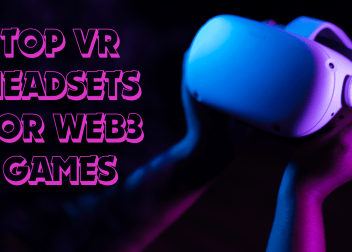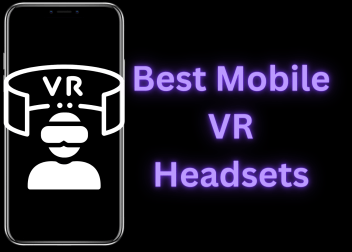Play to Earn Web3 VR Games
With the gaming world a new trend is coming up. Web3 VR Games are not really a new thing right now but they are definately going to create a new class of gamers. There are a couple of these games in the testing run and we are sure that as soon as they hit the market, these are going to attract great number of gamers. Let’s see why exactly these games are going to be the next big thing in the gaming world.
WEb3 VR Games: A New Era in Gaming
The gaming industry is undergoing a transformative shift with the convergence of Web3 technologies and virtual reality (VR) experiences. This amalgamation marks the advent of a new era in gaming, where decentralized principles and immersive environments come together to redefine the way we play and interact with digital worlds.
The Fusion of Technologies
As Web3 principles take center stage, decentralized platforms, blockchain, and cryptocurrency integration are reshaping the very foundations of virtual reality gaming. This heading delves into the technical aspects of this fusion, exploring how smart contracts and NFTs (Non-Fungible Tokens) are creating novel possibilities within VR landscapes.
Redefining Player Interaction
Beyond the technical realm, the convergence of Web3 and VR is fundamentally altering how players interact with games. Social aspects, digital ownership, and collaborative experiences are becoming integral components, fostering a sense of community and shared economies within these virtual realms.
The Promise of a Seamless Experience
Heading 1 explores how this convergence aims to create a seamless experience for gamers. From enhanced graphics and realistic simulations to the potential for true ownership of in-game assets, players are witnessing a paradigm shift in what is possible within the gaming space.
Innovative Trends: How Web3 VR Games Are Reshaping the Gaming Landscape
In the dynamic landscape of gaming, innovative trends are emerging as Web3 technologies and virtual reality (VR) games intersect. This heading explores the various ways in which this fusion is reshaping the gaming industry, introducing novel concepts that could shape the future of interactive entertainment.
Play-to-Earn Dynamics
One of the revolutionary trends is the concept of “play-to-earn,” where gamers can earn tangible rewards within the virtual environment. Through blockchain and smart contract integration, players can monetize their in-game achievements and possessions, creating a new economic model for gaming.
Tokenized Assets and NFTs
As Web3 VR games gain prominence, the integration of tokenized assets and NFTs becomes a crucial aspect. This section delves into how these blockchain-based digital assets empower players with true ownership, enabling them to trade, sell, or utilize in-game items across different gaming platforms.
Decentralized Governance in Gaming
Web3 VR games are not only transforming the player experience but also the governance structures within gaming communities. This heading explores how decentralized decision-making, facilitated by blockchain technology, is fostering a more inclusive and participatory environment for players.
Cross-Platform Connectivity
The convergence of Web3 and VR is breaking down traditional barriers, enabling cross-platform connectivity and interoperability. Players can carry their assets and achievements seamlessly between different games and experiences, creating a more connected and expansive gaming ecosystem.
Benefits of Web 3 VR Games:
The fusion of Virtual Reality (VR) and Web3 technologies in gaming brings forth a myriad of benefits, particularly from the perspective of Play-to-Earn (P2E). This convergence is not merely a technological union but a catalyst for reshaping the gaming landscape, introducing novel elements that enhance user experiences and offer unprecedented opportunities for players to monetize their gaming endeavors.
True ownership:
Firstly, the integration of Web3 principles in VR games introduces the concept of true ownership through NFTs (Non-Fungible Tokens). In a Play-to-Earn ecosystem, players can tokenize in-game assets, making them unique, scarce, and tradeable. This not only empowers players with tangible digital ownership but also enables them to participate in vibrant virtual economies where the value of assets can be realized beyond the confines of a single game.
Transparent reward system:
Moreover, the Play-to-Earn model facilitates a direct and transparent reward system. As players achieve milestones, complete quests, or contribute to the virtual ecosystem, they can earn cryptocurrency or other valuable tokens. This financial incentive transforms gaming from a leisure activity into a potentially lucrative pursuit, allowing players to earn real-world value for their time and skills invested in the virtual realm.
Better asset control:
The decentralized nature of Web3 further ensures that players have greater control over their assets and earnings. Smart contracts, operating on blockchain technology, automate and enforce the rules of engagement, guaranteeing fair and transparent distribution of rewards. This not only instills trust in the gaming community but also minimizes the influence of centralized entities, fostering a more democratic and equitable gaming environment.
Cross-platform interoperability
Additionally, the fusion of VR and Web3 opens up opportunities for cross-platform interoperability. Players can carry their earned assets seamlessly across different VR games and platforms, breaking down silos and creating a more interconnected gaming ecosystem. This not only enhances the overall gaming experience but also broadens the avenues for earning, as assets accumulated in one virtual world can be leveraged in another.
The problems with fusion of WEb3 VR Games:
Despite the promising era heralded by the fusion of Virtual Reality (VR) and Web3 technologies in Play-to-Earn (P2E) games, challenges emerge when scrutinized through the lens of the P2E paradigm.
One significant issue revolves around accessibility. While VR technology advances, not all players have access to the expensive hardware required for an immersive VR experience. This creates a potential divide where those with VR capabilities might have a distinct advantage in P2E games, posing a challenge to the inclusivity that P2E endeavors to achieve.
Moreover, another pressing concern is the scalability of blockchain networks. As P2E games incorporate blockchain and smart contracts to facilitate tokenized assets and in-game economies, scalability becomes a critical bottleneck. Network congestion and high transaction fees can impede the seamless flow of in-game transactions, affecting the overall player experience and limiting the potential for widespread adoption.
Simultaneously, security is a paramount issue. With the integration of blockchain and the use of cryptocurrencies in P2E games, there’s an increased risk of hacks and exploits. Players’ digital assets, often represented as non-fungible tokens (NFTs), become attractive targets for malicious actors. Ensuring robust security measures within the Web3 VR gaming ecosystem is imperative to safeguard players’ investments and maintain trust in the P2E model.
Furthermore, the nascent nature of regulations surrounding blockchain and cryptocurrencies introduces legal uncertainties. P2E games, operating at the intersection of VR and Web3, must navigate evolving regulatory landscapes, potentially hindering the widespread adoption of these innovative gaming models.
What does the future hold for WEb3 VR Games?
In this future scenario, VR immersion enhances the player experience to unprecedented levels. The fusion of VR and Web3 creates an intricate and lifelike virtual world where players can not only visualize but truly immerse themselves in the gaming universe. Furthermore, this heightened sense of presence contributes to a more visceral and engaging P2E experience, effectively blurring the lines between the digital and physical realms.
The integration of blockchain and smart contracts in Web3 VR games establishes a transparent and trustless foundation for the in-game economy. Consequently, players can truly own their virtual assets as non-fungible tokens (NFTs), fostering a sense of digital ownership and scarcity. This decentralized approach to in-game items and currencies introduces new avenues for player-driven economies, enabling the seamless transfer and trade of digital assets across diverse gaming platforms.
Crucially, the P2E future envisions gaming not merely as a leisure activity but as a viable means of income for players. By leveraging blockchain technology, players can earn tangible rewards for their in-game achievements and contributions. This economic model empowers gamers to monetize their skills and time investment, fostering a more sustainable and rewarding gaming ecosystem.
Moreover, the interoperability of P2E assets across various games and platforms creates a dynamic and interconnected gaming metaverse. Consequently, players can carry their digital possessions seamlessly between different virtual realms, contributing to the emergence of a cohesive and expansive gaming universe.


